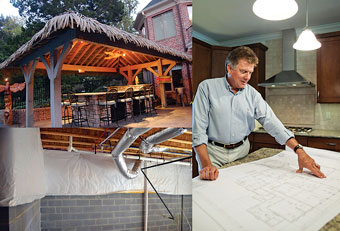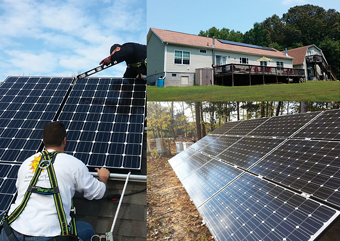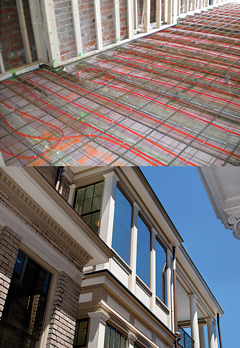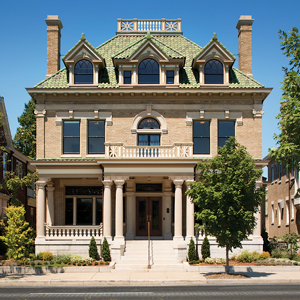Still reeling from the power bill you got after this winter’s brutal temperatures? No doubt, a lot of Richmond area residents are re-thinking their home’s insulation, at the very least. I know I am.
I’ve also learned that a lot of my house knowledge – gleaned when we bought our first home a couple of decades ago – is obsolete. Not too many years ago, we unrolled pink fiberglass insulation onto the attic floor, confident that the top section of our house was now sufficiently insulated. Turns out, we weren’t even close.

There are a number of investments – including insulation – to make your house more comfortable and more efficient. These run the gamut from a few dollars to tens of thousands; there is something for almost every budget. And even small steps can pay off big-time, reducing greenhouse gases and saving you money in the long run.
Eco-friendly products and techniques have come a long way in the past few years, according to Rich Napier, founder and president at Napier Signature Homes. New homes often feature a lot of these, including high-efficiency insulation, mechanical systems, and other attributes. Older homes often have thick walls and high-quality materials that have kept generations snug in the winter. But many homes, like my mid-fifties tri-level for example, could benefit from some upgrades.
Insulation is a great place to start saving energy. But instead of running to the big box store and buying the pink stuff, stop and think about what it is you’re trying to achieve.
“Having a plan is important,” said Paul Weissend, president of Dovetail Construction Company, which he runs with his wife, Julie. Dovetail is known for its use of the latest energy-saving techniques and products. The company’s Brook Road headquarters and the Weissends’ home in the Fan are showplaces for the possibilities of eco-friendly renovation. Rather than tackling projects haphazardly, try to prioritize needs and determine a budget for improvements.
“Think about your home as a long-term investment in comfort, energy efficiency, and your health,” he said.
Remember February’s chills and what you wore in the cold? “Wearing a hat keeps you warm,” said Julie Weissend, Dovetail’s vice president. “Wearing good, warm socks is important. It’s the same thing with a house.”
The better insulated your home is, the better it’s protected from the elements, be it February’s single-digit temperatures or August’s hundred-plus heat wave. Your house stays warmer in winter, cooler in summer.
Insulation is just basic physics, said Julie Weissend. “It’s the drafts that get you more than the temperature extremes. A basic tenant is to stop the air movement.”
So putting in the insulation isn’t enough. “You can put fiberglass in that sealed cavity, and if it’s sealed, that’s pretty effective,” said Paul Weissend. “But as soon as you put a hole in it, by putting a wire through, for example, there is air because you’ve got cracks that aren’t sealed.” Ductwork, especially in the attic, can benefit from sealing, eliminating a lot of the air movement.
Don’t ignore the walls, either. Insulating doesn’t mean you’ll have to rip out drywall.Napier explained, “If you’ve got a house that was built [a couple of decades ago], it just has minimal insulation in the wall. Now, we can blow in dense-packed fiberglass, basi-cally air-sealing all penetrations with foam. It makes the house a lot more comfortable.”
Thinking back to the analogy about wearing warm socks, remember that basements and crawl spaces need special attention to insulation.

Napier champions conditioned crawl spaces. “I’ve been doing this on all homes I’ve built since the mid-nineties,” he said. The right insulation, he said, makes the house warmer in winter, cooler in summer, and reduces condensation and moisture, which can cause big problems. It’s also fairly economical to do.
Wait. I’ve always been told that my house needs to breathe to be healthy, right? And the answer is yes, but not like I used to think.
“We need fresh air,” agreed Paul Weissend. “But you want to control the air that comes in to your house, not just have an air free-for-all. You don’t want contaminated air coming up from your crawl space, for example.”
Dovetail’s super-sealed offices use a machine called an energy recovery ventilator, which exchanges stale air with fresh air that’s gone through a fine filter to eliminate pollen, dust, and pollutants. “We lose only a small amount of energy, but get plenty of fresh air,” he said.
Today’s building codes are a lot stricter than when my drafty 60-year-old home was built, requiring a pressure test to check for escaping air. If your home is too tight, you may need the air exchange unit.
The last thing you want is to trap moist air in the house. A lot of guys yearn for a man-cave in the basement, and it’s a popular remodeling project. But don’t just put some heavy paneling on the walls, install a beer fridge and think you’re done. “If you don’t do it the right way, you can end up with a moldy, mildew mess,” said Paul Weissend. (And yes, I can personally attest to this.)
“That’s not healthy,” Paul added. “There are very specific techniques we use to keep a basement dry and the environment healthy. All the money you spent could be causing harm. And you ultimately have to do it again and that’s not green.”
While there are a lot of good building materials on the market today, a lot of the cheaper ones, like particleboard, basically can function as sponges.
“I think one of the problems is that for the past fifty to sixty years, we have turned our backs on good physics,” said Julie Weissend. “We’re working on an old farmhouse that introduced air conditioning about thirty years ago, and they’ve done more damage in the past thirty years than in the 200 before.”
So your house is insulated and breathing. What next?

Mechanical systems have seen tremendous improvement in the past decade. “That can be a long-term investment in comfort, efficiency, and health,” said Paul Weissend.
When your home is properly insulated, you might be able to get by with a smaller HVAC system (which could balance the cost of the insulation). Nobody likes having to shell out money for new mechanical systems, but there are upsides to the
new options.
Air conditioners are rated using a metric called Seasonal Energy Efficiency Ratio, or SEER rating. Higher SEER ratings mean greater efficiency. Since 2006, the federal government has mandated that all new central air conditioning equipment be at least SEER-13, but there is equipment available rated as high as SEER-18 and even SEER-23.
“The home-building industry needs to step up and promote the new products to help reduce carbon emissions and the use of energy,” said Napier. “Then, not only will we not have to build more power plants, the consumer gets the benefit of energy savings and cost savings.”
Other systems have vastly improved in recent years. In addition to HVAC systems, hot water heaters are much more efficient than just a decade ago. Geothermal heat pumps use the ground instead of outside air to provide HVAC and hot water. Because they use the earth’s natural moderate temperature, they’re very efficient. The Weissends use this in both their home and their office.
If geothermal is too much, homeowners might want to consider today’s tankless water heaters, which heat water only as needed, instead of keeping a full tank warm. There’s no need to be heating water when you’re not home, notes Napier. “The tankless heater doesn’t store water, but it uses a powerful burner to heat the water as you turn it on.” However, tankless heaters should be evaluated on a case-by-case basis, since their cost may outweigh the benefits.
Another consideration is windows. If your home has old or inefficient windows, it might be more cost-effective to replace them than to try to improve their energy efficiency.
But those with historic houses may find that reglazing, resealing, and using storm windows are necessary to preserve the integrity of the home. Adding storm windows reduces air leakage, improving comfort. Caulking and weather-stripping also can reduce air leakage around windows. Use caulk for stationary cracks, gaps, or joints less than one-quarter-inch wide, and weather-stripping for building components that move, such as doors and operable windows. And window treatments also can reduce heat loss in the winter and heat gain in the summer.
All these big upgrades may seem financially daunting, but the experts I spoke with agree that most will pay for themselves in energy savings in just a few years.
Lower bills aren’t enough for some people; they want to generate their own energy. Dovetail’s offices run on solar, but are connected to the grid with a net meter for cloudy or overcast days. Their energy costs are net zero. (The Weissends can even charge their electric car from solar energy). Net-zero energy means that the total amount of energy used by the building annually is roughly equal to the amount of renewable energy created.
The cost of installing solar systems in homes is coming down, said Bernie Stanley, owner of Shockoe Solar in Ashland. “I divide our solar customers into two groups: those who are interested in maximizing the reduction in their electric bill, and those who want to have power when the power goes out.” Going solar, he said, can pay for itself in about fifteen years.
Stanley uses Google Earth maps to determine if a customer’s home is suited for solar. Most are, and from there, the only limit is budget. “Solar doesn’t make sense for everyone,” he admits, “but a lot of people like to know that if there’s a power failure that lasts a few weeks, they don’t have to worry about getting fuel for a generator or sitting in the dark.”
Reducing your carbon footprint can also make a home more aesthetically pleasing. Lest you think green homes consist only of things you can’t see – admittedly, insulation is not sexy – consider the myriad of decorating options that offer green benefits along with style.

Take lighting, for example. Not only does proper lighting illuminate better, it’s been shown to improve health. Replacing your old 100-watt incandescent bulb with a 32-watt compact fluorescent light (CFL) bulb could save as much as $30 over the life of the bulb. CFLs don’t generate heat, use less energy, and last ten times longer than older bulbs. They are wanting in terms of light quality though, and a problem for the environment when it comes to disposal. LED lighting, in general, may be a better alternative. “LED lights are more expensive and they last a long time, so you have to be careful,” advises Paul Weissend. “The new lighting requires attention to detail. There is a big difference between different lights when it comes to color.”
When it comes to larger purchases, most homeowners know to look for the Energy Star logo on appliances such as refrigerators, dishwashers, and ovens. A tag on the appliance in the showroom will give you all the information about cost and electricity usage. Many large appliances, especially upscale refrigerators, generate a lot of electricity; Energy Star ratings can help you determine actual cost. Low-flow showerheads and toilets continue to improve in efficiency and in looks.
Going green, however, is about more than saving money. It’s also about ensuring your family’s health.
Typical household paint contains up to 10,000 chemicals, of which 150 have been linked to cancer. And some of the most harmful chemicals found in paint are volatile organic compounds, or VOCs.
Low-VOC paints are earth-friendly alternatives to traditional paints, said Stan Gasiorowski, district operations manager at Virginia Paint & Decorating Center. “Low-VOC means the paint contains either low quantities (less than fifty grams per liter) or no VOCs. Zero is your goal.”
Low-VOC paints often are recommended for people with respiratory ailments such as asthma. “We’ve had people call us saying they have children with respiratory diseases and these products were the only ones they were able to use that didn’t affect the child. It really can change your life,” Gasiorowski said. “It really hits home when you realize that there are situations where children’s lives can be improved by something like environmentally-friendly paint.”
Just as paints can be sources of toxins, many traditional flooring options typically rely on harmful chemicals. Earlier this year, one area flooring company’s stock plummeted when a news program claimed its products included formaldehyde. It’s important to research products thoroughly; consider asking for the manufacturer’s Material Safety Data Sheet (MSDS) from the supplier.
But there are great options. Cork or bamboo floors, for example, come from renewable sources, offer insulating properties and don’t always require glues. Many carpets today are created from recycled materials, and using carpet tiles makes it easy to replace a section that is damaged without ripping out an entire room’s worth.
And while you should be vigilant about protecting your home and your family, don’t stress. While eco-friendly might be today’s buzzword, the concept isn’t new. Your grandparents did it all the time.
Think about repurposing, for example. Reclaimed wood, for example, is a great choice from an environmental and decorating standpoint. When the Weissends were renovating their office building, old structural purlins were transformed into countertops, accent shelving, and bathroom vanities.
You may not know your lumber’s heritage, but you can still be responsible. “Purchase Forest Stewardship Council (FSC) wood so you know that it’s sustainably grown, sustainably harvested, and sustainably replenished. There’s a chain of custody that goes with wood,” said Julie Weissend.
When you’re redecorating, think about repurposing instead of discarding. Almost everything from bricks to flooring to fixtures can find new life elsewhere. Habitat for Humanity accepts donations that it can sell to fund its projects (their ReStores also are a great place to find appliances or cabinets or other items for your own home).
Though budgets are always top of mind, the most important part about thinking green is the effect it has on the next generation. Not only will our children have a healthier world, it may inspire them to continue finding ways to improve efficiency
FACTS TO CONSIDER:
Approximately 30 percent of energy used in buildings is used inefficiently or unnecessarily.
The U.S. houses 5 percent of the world’s population, but uses 23 percent of the world’s energy.
A crack as small as one-sixteenth of an inch around a window frame can let in as much air as leaving the window open three inches.
A compact fluorescent bulb (CFL) uses 75 percent less energy than a traditional incandescent bulb.
U.S. energy consumption could be cut by 11 percent by 2020 through simple building efficiency measures such as more efficient lighting, water heating, and appliances.
Factoids courtesy unitedweserve.gov and Class 5 Energy.




